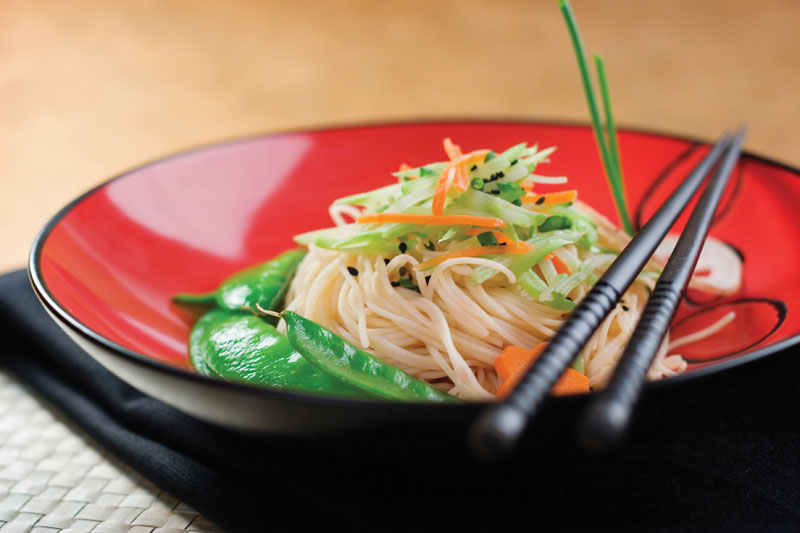Americans frequently select meals out of convenience rather than considering their health benefits, Hogan says. They cook the same 10 to 12 meals on rotation, deferring to options that require the least effort and the shortest preparation time, including prepackaged meals, fried foods and fast foods.
In other cultures, there is more emphasis on eating locally grown whole foods. The benefits of this practice are best evidenced in the Mediterranean and Asian cultures where diets traditionally focus on fresh fruits and vegetables. People residing in these regions often have the highest life expectancies.
“Food is much fresher and not as much goes to waste,” Hogan explains, recalling when her husband, an air traffic controller in the Navy, was stationed in Greece. She remembers placing her order at a Greek restaurant and watching as the chef walked across the street to a produce stand to purchase ingredients for her meal.
Americans typically do not limit themselves to what is grown or produced locally and what is in season, but opt for foods carted in from far away and treated or processed to make them more shelf stable.
The problem? “Fruits and vegetables are most nutrient rich when picked,” Hogan says. “Their nutrients gradually diminish as they are transported and stored in grocery stores. To get the most out of your grocery budget and do what’s best for your health, minimize the time your food spends from the field to your plate.”
When foods are processed, they are stripped of fiber, healthy oils and nutrients, Hogan adds. Preservatives and solid or hydrogenated fats are added to keep items fresh while artificially produced nutrients are reintroduced. Other cultures have a different focus when it comes to food. They take the time to prepare meals beginning with regular—often daily—trips to the market and butcher, Hogan says. They prepare meals with smaller portions and more flavors.
In the Mediterranean and Asia, people consider the nourishing aspects of the whole meal. Traditional meals in Asia and the Mediterranean typically consist of grains, fish, herbs for flavor and large portions of nutrient-rich produce. They serve other forms of meat as a garnish or side dish and use healthy fats like olive oil in meal preparation.
Soups and rice are a regular part of Asian meals—including breakfast— Hogan explains. “The health benefit comes mostly from what they’re not eating. They’re consuming a balanced meal from simple, wholesome ingredients versus refined sugars and processed cereals.”
As Americans, we tend to obsess over the health benefits of one ingredient —for example, Omega 3 fatty acids, fiber, water or vitamin C. The problem is when we don’t see the big picture and rely too heavily on one specific nutrient. To be healthy, we need a variety of nutrients. There’s no magic pill.
Mediterranean and Asian diets tend to have the right balance of nutrients to prevent certain chronic diseases and assist with weight maintenance, Hogan says. But there is more to these diets than the food. “It is how we are eating just as importantly as what we are eating,” she stresses.
[quote]As Americans, we tend to obsess over the health benefits of one ingredient —for example, Omega 3 fatty acids, fiber, water or vitamin C. The problem is when we don’t see the big picture and rely too heavily on one specific nutrient. To be healthy, we need a variety of nutrients. There’s no magic pill.[/quote]Healthy Dining Practices
Too often, Americans rush through meals and overeat. In the Mediterranean and Asia, people set aside time to eat with family and friends. In Greece, meals can last two or three hours.
In many countries around the world, it is rude for wait staff to bring a check before customers ask. Restaurant patrons can spend the entire day if they want to, Hogan says. While living in Greece, she saw restaurant patrons playing cards during meals and spending more time talking than eating.
In Greece, it is about the experience more than the food, she says. Restaurants often prepare one or two main entrees in the morning, and patrons can take it or leave it. It is a more relaxed atmosphere, which can aid digestion and give your body time to realize when it is full.
Eating with chopsticks as they do in many Asian cultures can also help you realize when you are full, Hogan says. When you eat with chopsticks, you can only pick up small amounts of food at a time. This forces you to slow down, she explains.
Eating from small plates as they do in Asian and Mediterranean cultures can help you regulate your portions, she says.
Dinner plates in America are the size of serving dishes in other cultures, Hogan says. “We instinctively fill our plates without thinking about it and typically eat what’s in front of us. If you start on a smaller plate, you can cut back on calories while still enjoying your meal and not feel deprived.”
How to begin eating healthier
In the Mediterranean tradition, eating well begins with shopping for ingredients.
Farm markets and farmers’ markets sell local produce and sometimes grains and free-range meats. Farmers can usually tell you where to purchase the ingredients they do not sell, Hogan explains.
Stores like Heritage Market, Trader Joe’s and Whole Foods also sell healthy ingredients, she says.
Additionally, you can ask the manager to order ingredients not sold at your local grocery store.
If people start asking for certain items, they will keep them on their shelves, Hogan says. “You vote with your dollar. It would be so much easier if we demanded what was right for us. We say we want it when we pay for it.”
If you are not familiar with traditional Mediterranean and Asian recipes, there are several websites dedicated to helping you find cooking strategies, tips for stocking your cabinets and recipes.
Health-conscious, culturally themed restaurants can also serve as a reference as eating there can give you a feel for what certain ingredients and menu items should taste like. Some restaurants will even share recipes.
While the culinary traditions of Spain, Italy, China, Thailand, Japan and Vietnam are represented in restaurants across the United States, these representations often differ from the cuisines we would find in those nations. In America, recipes are influenced by other cultures’ diets and the nuances of the typical American diet, Hogan says. We have our own expectations of how menu items should taste based on our culture.
You can use the Internet to research most restaurants ahead of time, but when dining out, be sure to ask if menu items are prepared in traditional ways. Traditionally prepared Mediterranean and Asian dishes contain large portions of fruits and vegetables. They are not full of sodium and MSG.
Hogan recommends incorporating a variety of grains into your diet. Millet, served in Asia and in the Mediterranean, has several applications and can be a good source of vitamins and fiber.
From the Asian tradition, Edamame—a type of soybean—can also serve as a healthy addition to your diet.
Hummus, from the Middle East and Mediterranean tradition, is a good source of protein, fiber and healthy fats. Made from chickpeas, hummus can be a good salad topping, dip or healthy replacement for mayonnaise or cream cheese.


